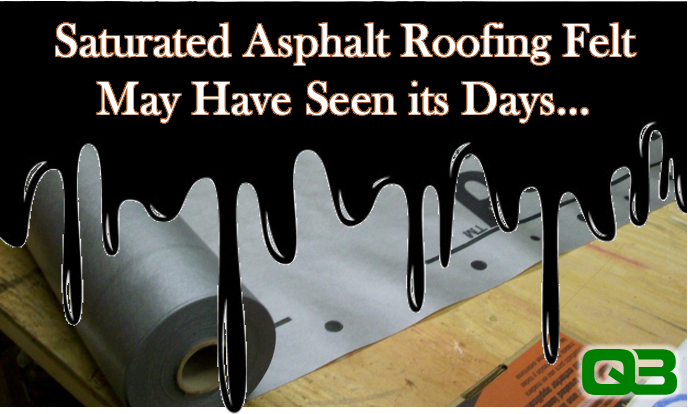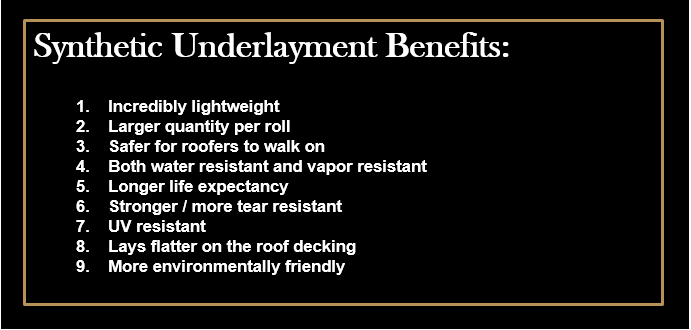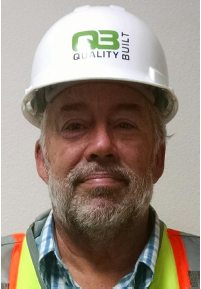Roofing felt, commonly referred to as tar paper, saturated felt paper, or underlayment, is a felt paper that commonly comes in either a 15# or 30# weight roll measuring 36 inches wide. The numbers relate to the weight accumulated over a 100-square-foot area and used to be the actual weight of material to cover the 100-square-feet. Today, felts typically weigh less per 100-square-feet yet have kept the traditional name.
Saturated felt paper has been on the market for nearly100 years and has been the standard underlayment product for various roofs with little to no competitors until about ten years ago when synthetic underlayments were introduced. Going forward the green building trend will likely spell the demise of traditional roofing felt at least in many markets. If nothing else the materials and manufacturing process will need to change.
Synthetic Roof Underlayments
Synthetic underlayments have historically been more expensive over traditional felt paper underlayment and until recently for this reason they have made a relatively slow emersion into the market. In the online article “Roofing Underlayment Types”, authors Nick Gromicko and Kenton Shepard predicted that “by, 2014, [saturated felt] will no longer be installed at all” (InterNACHI). While we agree saturated felt will likely not be used in the future, the nationwide transition that the authors at InterNACHI predicted did not happen as rapidly as they thought. This could have been for a number of reasons, including cost and uncertainty about the new product. It is difficult for an entire group to transition to a new product, as they are timid and reluctant to change what they are accustomed to despite any potential benefits.
Today, the cost of synthetic underlayments are beginning to come in line with traditional felts, and are therefore being used more and more frequently. This trend has become particularly evident as we reviewed data from the thousands of projects we have inspected and observed over the past few years. The transition to synthetic underlayments has been noted to be taking place regionally, with the greatest impact being in the southeast with isolated pockets in other regions. We believe that the green building trend, along with increasing air tightness requirements and the un-vented attic concept may act as catalysts to the transition from traditional asphalt roof underlayment to synthetics.
1. Incredibly Lightweight
Synthetic felts can be extremely lightweight in comparison to traditional saturated felt underlayments. For example, Owens Corning ProArmor (synthetic) comes in a nearly 1,000 sq. ft. roll and weighs just 25 lbs., compared to GAF Shingle-Mate Felt Underlayment (saturated) that weighs 36 lbs. at 400 sq. ft. While this reduction in weight may not result in any changes to the structural design, the reduction in weight reduces fatigue and stress on the installer, thus reducing the risk of injury.
2. Larger Quantity Per Roll
Because synthetic underlayments are more lightweight, more material is able to be placed on each roll. More material on each roll means longer runs and fewer seams during application. The benefit of having fewer seams is reducing the risk of water intrusion.
3. Safer for Roofers to Walk On
Many manufacturers are creating a surface on their underlayments designed to reduce the potential for slipping. For example, in the ICC ESR report for CertainTeed Diamond Deck Underlayment, the description indicates that it consist of “a woven base with a layer of nonwoven polymer laminated to the bottom and a non-slip coating on the top.” Although workers should be wearing appropriate PPE while working on dangerously sloped roofs, having a surface that reduces the potential for slipping acts as an excellent agent to reducing injuries. Also, workers may work more efficiently if they are comfortable knowing that the risk of slipping has declined. As inspectors, we understand the mental comfort that comes from working on a surface that gives you better grip in comparison to the anxiety of walking on surfaces when your footing is tenuous. Traditional saturated felts can have an oil residue that especially when mixed with moisture can lead to slipping.
4. Both Water and Vapor Resistant
All synthetic underlayments are designed to be water resistant. Many others can also be either vapor resistant or vapor permeable (breathable). Your architect or building envelope consultant will need to look at the entire roof as a system, as well as take several other factors into consideration in order to decide whether a vapor resistant or vapor permeable synthetic underlayment should be installed. Based on studies performed by Owen’s Corning; if you are using shingles especially multi-ply shingles, the shingles already create a vapor resistant layer, so the concern raised by some about needing a breathable underlayment is not valid. On the other hand, this vapor resistance can be a disadvantage with wood-type roofing, since wood-type roofs ideally need to dry on both sides.
There are concerns raised by The Cedar Shake and Shingle Bureau (CSSB) warning that synthetic underlayments may create adverse conditions with wood roofs. The vapor barrier characteristic makes these underlayments ideal for use with metal roofing materials according to many manufacturers.
For more on Vapor barriers, see our Tech Alert - "The Ever-Evolving Building Envelope: Part 2: Air Barrier Fundamentals"
For more on roofing trends and utilizing proper underlayment materials, stay tuned for our upcoming Tech Alert; “Current Best Practices for Roofing Underlayment”.
5. Longer Life Expectancy
Grace Construction and Packaging’s website page about Tri-Flex® states the following: “Felt has many drawbacks when used as a water-shedding barrier. First and foremost, felt degrades over time. This can leave the roof vulnerable to leaks and eventually can lead to costly repairs. Tri-Flex® synthetic roofing underlayment does not degrade over time and can maintain its water-shedding ability throughout the life of the roof.” This statement suggests that synthetic underlayment can outperform traditional saturated felts. The warranty for this product would appear to back up that statement, being listed at 25 years. In contrast, the 30# felt manufactured by Tamko Building Products clearly indicates it carries no warranty according to the manufacturer’s technical data on their website. Based on this comparison, the 25 year warranty is a significant improvement.
Of all of the benefits of synthetic underlayment, this one is the one we cannot yet verify. We have yet to inspect forensically a roof with a synthetic underlayment installed that is more than a few years old. These products are newer to the market and there are not a lot of older installations to be found. Manufacturers have conducted extensive accelerated aging tests, and obviously believe the products will last beyond their warranty periods, but laboratory tests don’t necessarily capture the effects of the real world. Time will tell if they are as long-lasting as indicated by the warranty periods.
6. Stronger/More Tear Resistant
Manufacturer specifications and claims indicate that they consider synthetic underlayments to be a superior product over traditional saturated felts, because of its increased durability and life expectancy. Grace indicates the following related to the strength of their Tri-Flex® product: “Strength is another area in which Tri-Flex® is superior to #30 felt, offering 20 times the protection, giving it the ability to withstand even the strongest wind conditions”.
This is a benefit both during construction and throughout the life of the roofing. Underlayment is subject to tearing during installation both from unrolling and pulling it into place, as well as from forces of nature such as gust of wind. Although dealing with such tears is not very expensive or time consuming in the short run, such an inconvenience is sure to add up in the long run. Synthetic underlayments are optimal due to their tear resistance during application, as well as during the lead time waiting for roof installation. There are some regions where high wind issues are a real concern and scheduling may require the roof contractor to provide a water-tight condition before the roof is installed. This sets synthetic underlayments apart from asphalt felts because synthetic underlayments offer both a water-tight condition and resist being blown off by high winds.
In the photo you can see that the roof covering and underlayment both were blown off of the roof exposing the OSB sheathing. If this occurs before the home is sold and covered by homeowners insurance this could result in substantial cost including delays in delivery of the home. A stronger more tear resistant underlayment may stay in place reducing the damage to interior finishes thus saving both replacement costs and time delays.
7. UV Resistant
Synthetic underlayment is resistant to UV damage and some can be left exposed to the weather up to six months. This is a real benefit when construction sequencing requires a delay between installing the felt and the roof covering.
8. Lays Flatter on the Roof Decking
When asphalt saturated felt is being installed, it often wrinkles because the paper is affected by moisture in the air. For shingle roofing installations, this is a significant cosmetic issue as the wrinkles telegraph through the shingles. To combat this; current practice with shingled roofing is to install the shingles immediately following the felt to protect the felt from wrinkling. On larger roofs, only a few courses of felt is able to be installed at a time using asphalt saturated felt. Once a few courses have been installed, the roofer proceeds to install shingles before the felt has a chance to wrinkle. This approach leaves areas of the roof vulnerable to water intrusion if a sudden storm were to occur. Unfortunately, asphalt shingle roofs are most common in regions where such weather conditions are prominent.
Synthetic underlayments are not affected by moisture like traditional felts and do not wrinkle.
9. More Environmentally Friendly
The green building trend will likely spell the demise of traditional roofing felt at least in many markets. The synthetic underlayments carbon foot print along with its physical characteristics, including the ability to be an air barrier and vapor barrier, sets it apart from traditional felts in terms of its energy efficient design. Since synthetic underlayments are not comprised of asphalt (tar), they are considered to be more environmentally friendly. Also, several manufacturer’s use recycled materials to produce their synthetic underlayment product. Synthetic felts can also be considered to be a more environmentally friendly approach, as they are anticipated to have a longer life expectancy than traditional felts and therefore may not need to be replaced as often. Additionally, because the product is able to hold up against intensive weather conditions, the rate at which the material should be replaced should not exceed that of traditional roofing felt.
The Bottom Line
No final conclusion can be made regarding synthetic underlayments with the data that has been collected thus far. However, it is evident that the product retains positive long-term performance characteristics and that it is being used more commonly in construction. We have noted that in synthetic underlayments resist tears and wrinkles, avoid moisture damage, and are UV resistant for a longer period of time than traditional felt underlayments.
As with all items that affect the integrity of a structure, especially those that affect the weather resistance, we would recommend a third party QA review. This review should include a Technical Plan Review to review the products and details for items that may cause risk, as well as an inspection during the installation of the products. The fact that most synthetic underlayments can be exposed for up to several months before they need to be covered means that the roof cladding installation does not need to occur immediately following the felt installation. This can leave a window for a third party QA inspection to occur and given the importance of the underlayment to protecting the structure from water intrusion this would be a recommended practice.
ABOUT THE AUTHOR
Monty has over 35 years of experience in the construction industry and has performed hundreds of inspections including forensic investigations, remediation, and quality control inspections for commercial and residential construction. Monty is a seasoned expert witness for construction defects, specializing in exterior and interior investigations and analysis for litigation, while working closely with insurance adjusters and attorneys for dispute resolution, contract performance analysis, and claims.
You can reach Monty at: [email protected]


